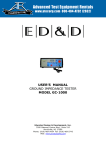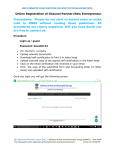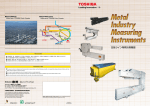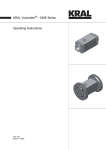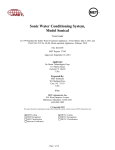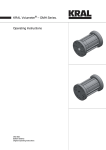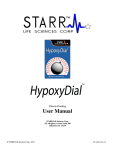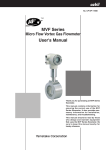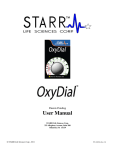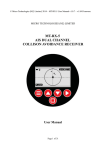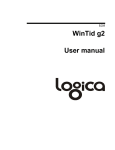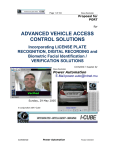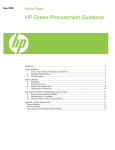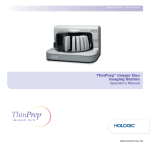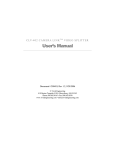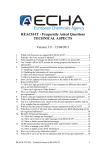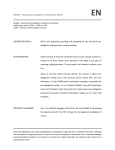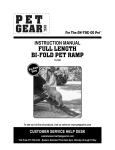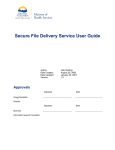Download PDF File - Planet CPR Product Safety Compliance Research Report
Transcript
November 1, 2011 Planet CPR Product Safety Compliance Research Report Please note that this research project was limited to an overall review of the available product information and prototype (external review only). This project and report is excellent preparation for a full UL/CSA/CE/IEC evaluation. However, it is not a substitute for the detailed, clause by clause review that occurs during the actual certification evaluation (which also includes compliance and validation testing). The goal of this project was to identify the path to compliance and provide guidance towards compliance. While every effort was made to be as complete and thorough as possible, additional issues could be identified during the actual certification evaluation. General: 1) Turbine Classification: During our discussions, you mentioned model variations that cover a considerable span in output power – as I recall, ratings as high as 30 MW were mentioned as a possibility. Please note that the Hydro turbine industry has created the following turbine classifications based on output rating – these are relevant as different standards apply to different turbine classifications. a) Micro-Hydro: up to 50 KW or up to 100 KW depending on the source/standard. b) Mini-Hydro: up to 1 MW. c) Small Scale Hydro: up to 30 MW. 2) Turbine vs. Turbine Generating System: a) The turbine itself, being a fully mechanical device with no electrical parts, is unlikely to be required by an inspection authority to have product “certification”. b) However, the turbine is not a standalone device. In many cases, it is likely to be connected to an electrical generator as well as other possible electrical devices. The overall system is likely to be inspected by the local authorities. Any compliance problems with the generator will prevent the system from being operated. Consequently, you may wish to consider recommending or providing a generator which you know is certified for the installation country/location. c) We recommend that you consider providing as much detail on the recommended system, system parts, system preparation, and system installation as possible in an effort to help limit installation problems. Providing a raw turbine to the wrong group could lead to haphazard installation and poor results – results that may bear negatively on your product/company even though you are not responsible for or in control of the installation. 1 901 Sheldon Drive Cary, NC 27503 USA Tel: 919-466-9283 Fax: 919-228-4065 3) Country of Destination: The first step towards compliance is to identify the countries in which you plan to market. For compliance purposes, countries are grouped as follows. a) b) c) d) US, Canada, European Union, International = all countries other than the US, CAN, & the EU countries 4) Product Specifications: Typical required specifications for water turbines include: a) Generic Type or description of the turbine, including its layout (shaft details = vertical, horizontal, or angled), b) Company name and contact information, c) Product name and/or model number, d) Outline drawing giving main dimensions and locations of the output shaft(s) and turbine fixing points, e) Intended method of control of water flow through the turbine, f) Rated head and flow in the units typical for the country of destination (i.e. head in meters and flow in liters per second). g) Head and flow operational range, h) Efficiency over the specified flow range, i) Output at the rated head and flow (kW at the shaft), j) Shaft rotation speed and direction, k) Runaway speed at maximum rated head, l) Environmental ratings (ambient temperature, humidity, altitude, etc.), 5) Product Markings: Typical markings required on the turbine include the following. Markings and labels should be “permanent”. a) b) c) d) Company name or trademark, Country of manufacture, Model number, Serial number or other specific product code • We have also seen information that suggests that it is industry practice to mark a serial number on major internal parts such as a runner or drum for maintenance purposes, e) Product ratings 6) Instruction/Installation Manual: a) Each turbine should be provided with a user’s manual with operating instructions. The user’s manual should also include the product specifications as well as the name and address of the supplier. It is also advisable to reproduce all product markings in the manual, adding related details as appropriate. a) Each turbine should be provided with installation instructions. Details on fixing the turbine in place, inlet and outlet connections, and any details on specific hardware and plumbing to use. Adequate warnings should be included to protect the user from high pressure and the rotating shaft(s). Considering your intended international customers, pictures with attention getting arrows/highlighting are advisable to help minimize wording (that could need translation). 2 901 Sheldon Drive Cary, NC 27503 USA Tel: 919-466-9283 Fax: 919-228-4065 Compliance & Certification: “Compliance” refers to verifying that your product complies with the standards; “Certification” refers to having a 3rd party certify that your product complies with the standards. 7) General Certification Comments: a) As your product is mechanical only (no electrical parts), it is quite possible that you will find that no official certification requirements apply to the turbine. In fact, you may wish to pursue sales of your product while listening to feedback from the customer as to local regulatory requirements. Many countries which are not highly developed may have no regulatory requirements. • As we discussed, sometimes the prospect for jobs and or the generation of electricity may outweigh any local inspector/regulatory concerns in lesser developed countries. b) However, since your product is attached to an electrical generator, it is likely that some government inspectors will require that the “hydraulic generator system” (turbine plus generator) be certified. If you find this to be a problem, you may wish to identify and/or provide suitably certified generators. See comments in item 2 above. 8) Product Safety Standard Overview: a) US product safety standards are typically written and titled “UL” (Underwriters Laboratories), b) Canadian (CAN) product safety standards are typically written and titled “CSA” (Canadian Standards Associations), c) European Union safety standards (CE mark program) are prepared by CENELEC and are titled “EN” (European Normalized), d) International safety standards (beyond North America & the EU) are written and titled “IEC” (International Electro-technical Committee). 9) General Product Safety Hazard Re view: In general, there are 6 hazards the UL and CSA standards focus on protecting the user. See Attachment A for a review of the 6 hazards for your product. 10) Safety Standards: a) US – UL: There are no established US-UL standards for water turbines. A generator/turbine “system” is to comply with UL508, the Standard for Industrial Control Equipment. b) CAN – CSA: There are no established CAN-CSA standards for water turbines. A generator/turbine “system” is to comply with CSA22.2No.14-10, the Standard for Industrial Control Equipment. c) EU: Small scale turbines are subject to EN61116 the Electromechanical Equipment Guide for Small Hydroelectric Installations (http://shop.bsigroup.com to purchase EN standards). This is the primary CE mark standard for the EU. Additional standards may be applicable under the Machinery Directive (risk analysis + the rotating machines standard may be applicable depending on your instructions). • We noticed some foreign tax credit programs specify hydro turbine installations must comply with this standard to qualify. d) International: Small scale turbines are subject to IEC61116 the Electromechanical Equipment Guide for Small Hydroelectric Installations. This standard is identical to EN61116. 3 901 Sheldon Drive Cary, NC 27503 USA Tel: 919-466-9283 Fax: 919-228-4065 11) US/CAN Certification: Initial response from US-UL certification labs is that they do not want to certify the mechanical turbine only. They would consider certifying the combination of the turbine and a generator. For the turbine only, it was recommended that a letter report with the compliance and validation test data may suffice. 12) The EU-CE Program – Overall Comment: The first thing to know about CE is that a “CE mark” can mean many things = in order to know what a specific CE mark means, you must see the manufacturer’s supporting document titled “Declaration of Conformity” (DoC). The DoC lists to what EU Directives and Standards the product complies = it can list required standards and/or optional standards. This is very important for two reasons: a) Two competing products may both have a CE mark but their CE marks could mean vastly different levels of compliance = it’s important that you know that the CE mark only means whatever is on the DoC. b) You will have some choice on how much or how little you comply with for your CE mark. And it can be additive – including more standards over time. c) Under this project, we have focused on product safety = we have identified the applicable product safety directive/standard for this product below. 13) CE Mark Process: To sell your product in the European Union, the product must bear the CE mark. For your type of product, the CE mark program is “selfcertification” (not required to “certify” the product with an independent lab – test report with data is sufficient without ongoing production inspections). The overall CE process is: a) Determine the EU Directives applicable to your product, b) For each EU Directive applicable to your product, determine the standard(s) under the directive that best fits your type of product based on the scope of each standard, c) Verify that your product meets the standard(s) identified in step b = this includes construction, labeling, and instruction manual evaluation to the standards plus testing and a compliance report, • The manufacturer is to maintain a “Technical Construction File” (TCF) for each product which includes a report showing clause by clause compliance with the standard, the test data, copies of the manuals/labels, schematics, diagrams, etc. If European authorities ever question your DoC, they have the right to request your TCF to verify compliance of products bearing the CE mark. d) Prepare a “Declaration of Conformity” (DoC) listing the Directive(s) and Standard(s) with which your product complies. The DoC must be signed by an officer of your company, e) Affix the CE mark to your product (buy labels @ www.productsafeT.com or print yourself), f) Include at least 3 copies of your signed DoC with each shipment (i.e. 3 copies of the DoC with the Packing List = allowing each inspector to take a copy), g) Consider including a copy of your DoC with each unit (i.e. print in the back of your manual) , 4 901 Sheldon Drive Cary, NC 27503 USA Tel: 919-466-9283 Fax: 919-228-4065 14) CE Mark – Hydro Turbine: a) Turbine Only – comply with the Machinery Directive (mechanical safety). The Machinery Directive includes a list of over 800 standards to be considered (most of the standards are product specific so many will not be applicable to the turbine). The exact standards that apply are determined during an initial Risk Assessment which is part of the CE certification process. The primary standard has been identified as EN61116 as noted above. b) Turbine System with Generator – comply with the Machinery Directive & the Low Voltage Directive (electrical safety), and possibly the EMC directive (depends on design of generator). For the Low Voltage Directive, the generator standard would apply – therefore, if you do decide to develop a system, be sure to select a generator that can provide a Declaration of Conformity and Certification reports that show the generator meets the Low Voltage Directive and the EMC Directive (if applicable = if high frequency electrical circuits are incorporated in the generator design). 15) International Compliance: This applies to all countries beyond the US, Canada, & the European Union. The first step is to identify whether the country is a member of the IEC. Countries who are members of the IEC agree to use the IEC standard as their country’s national standard. We have verified that India and South Africa are IEC members. Therefore, compliance with IEC61116 is applicable for these countries. Since IEC61116 is the same as EN61116, if you prepare a CE report to the EN standard, it will also satisfy most other countries outside the EU. • Also see Attachment C regarding international standards for tendering documents. 16) Compliance Issues: In a brief review of the turbine requirements per the standard IEC/EN61116, we identified these items to consider. We recommend that you obtain a copy of this standard and familiarize yourself with the small scale turbine and turbine generator system requirements. a) Maintenance: The standard specifies that the material of the unit, especially the runner and other parts subject to wear, should be easily repairable. There doesn’t appear to be any way to easily access the inside of your turbine. b) Corrosion & Wear Protection: The standard places a lot of emphasis on this topic. c) Flexible Couplings: A coupling is recommended in the standard to avoid alignment issues. We also discussed during my visit if this could help with a “hard start” of the turbine (slam start to the generator). Compliance & Validation Testing: See Attachment B for proposed test plan. 17) Your Testing Comments: Most of the parameters you discussed with Clark Testing are included in the test plan per attachment B. You mention 10 data points, which is a good number considering your objectives for the test data (compliance, validation, and marketing purposes). 5 901 Sheldon Drive Cary, NC 27503 USA Tel: 919-466-9283 Fax: 919-228-4065 Next Step: a) Let’s schedule a phone conversation to review the report together. b) Once we are clear on what testing/validation/reports you would like performed and how long we think that will take, I will provide these details to our Sales Team so that they may provide you with a quote for the test phase of the project. c) If you would like any assistance with the instruction manual development, markings, or any other assistance, please let me know. Sincerely, Reviewed by: Bill Bisenius Senior Project Engineer Brad Collison Engineering Manager 6 901 Sheldon Drive Cary, NC 27503 USA Tel: 919-466-9283 Fax: 919-228-4065 Attachment A Product Safety Hazards Overview Holden Hydro Turbine In general, the product safety standards are intended to encourage products that protect the user from 6 potential hazards: 1) Risk of Shock: prevent access to voltages greater than 30 VRMS, 42.4 Vpk, or 60 VDC (access determined with accessibility probes). Requires 2 levels of protection to accessible circuits (double or reinforced insulation between hazardous circuits and SELV circuits = use power supplies with SELV certified outputs whenever possible). • The turbine is mechanical only – it does not incorporate any electrical circuitry. Therefore it does not have voltages that are considered a risk of shock. • However, the turbine is intended to be connected and adjacent to an electrical generator. As such, the primary consideration for Risk of Shock is to protect the generator from damage caused by the turbine that could result in a shock hazard to the operator. For example, could the turbine leak and spray water onto electrical circuits of the generator? 2) Risk of Energy: prevent access to circuits “capable” of delivering 240 VA or more (regardless of voltage), • The turbine is mechanical only – it does not incorporate any electrical circuitry. Therefore it does not have parts that are considered a risk of energy. • However, the turbine is intended to be connected and adjacent to an electrical generator. As such, the primary consideration for Risk of Shock is to protect the generator from damage caused by the turbine that could result in a shock hazard to the operator. For example, could the turbine leak and spray water onto electrical circuits of the generator or a battery storage system? 3) Risk of Fire: limit fuel to a fire by using certified flame rated combustible materials (plastics, circuit boards, wiring, etc.); and by designing the outer enclosure to contain fire if a fire should occur inside the product as a result of a fault condition, • We did not identify any combustible materials used in the construction of the turbine. • The primary consideration for Risk of Fire is to protect the generator from damage caused by the turbine. For example, could the turbine leak and spray water onto an adjacent generator/electronic causing a fire. 4) Risk of Injury: prevent access to moving parts, sharp edges, etc. This is the primary hazard concern for compliance of the turbine construction. • The turbine should have rounded edges in all operator accessible areas. • The primary concern is whether any failure mode could result in the turbine exploding or otherwise sending shrapnel flying through the air that injures a person. 5) Risk of Radiation: prevent/limit access to sources of radiation (laser, UV, microwave, etc.), • There are no radiating parts in the turbine and the turbine is not intended to be used with radioactive substances. 7 901 Sheldon Drive Cary, NC 27503 USA Tel: 919-466-9283 Fax: 919-228-4065 6) Risk of Chemicals: prevent/limit exposure to hazardous chemicals; prevent hazards from spills for products using liquids. • The turbine is only intended for use with water and is to be located in an “ordinary location” (no hazardous substances or fumes). 8 901 Sheldon Drive Cary, NC 27503 USA Tel: 919-466-9283 Fax: 919-228-4065 Attachment B Proposed Testing Holden Hydro Turbine We have reviewed numerous guidelines for water turbines and water turbine systems. During this process we identified the following water turbine tests to consider for safety compliance and product validation purposes. Please review this attachment thoroughly = your input is critical in selecting and defining the test program. Product Families: Specific differences between models should be reviewed in order to determine which model(s) should be tested. A product family can be certified by testing select model(s) within the family and providing the necessary extrapolation to justify the representative testing. In general, worst case conditions are to be tested. If a single unit can be shown to be the worst case for all models in the family, then it can be the only model tested. In some cases testing the largest and smallest units is appropriate. In other cases, a greater sampling is needed. Many times a single model is subjected to full testing and other sizes are subjected to one or a few tests on the variations. It all depends on the design and rating differences between models. Compliance Testing of the Turbine: As discussed in the main body of the report, “certification” of the turbine may not prove to be necessary. Regardless, you should consider the following compliance tests and the resulting effect on the turbine. In general, what single fault conditions could occur in use and how would the turbine respond? A) Maximum Bearing Temperature: Are the bearings stay within their ratings? (this is a worst case normal operation consideration) B) Exceeding Runaway Speed: What would occur if the input pressure exceeded the maximum rating? Could a hazard occur? Your installation instructions may need to mandate pressure monitoring devices with an alarm system depending on the results of this condition. C) Hydrostatic Pressure Test: Block the output of the turbine and apply 2x the maximum rated input pressure to the turbine for 15 minutes. During the test, there should be no significant leaking, no loosening of parts, and no potential injury conditions. Higher safety factors above 2X can be considered based on your desired level of compliance. D) Debris in the Water: This is related to your instruction manual and specifications for filtering incoming water. What would occur if the wrong filter was used, if the filter failed, or if the filter fell off? How large of debris could enter the turbine and what would be the worst case situation? = could debris suddenly jam the turbine while at high speed creating an “explosion” within the turbine? E) Loss of Turbine Fin: If applicable, what would happen if a fin became loose? Is there any other internal part that could come loose or break off? (i.e. a part that could become a projectile). F) Other: It is in your best interest to identify all possible fault/failure conditions and insure that your turbine does not present a hazardous condition to persons = should additional fault tests be conducted? As discussed and outlined in Attachment A, the primary concerns are any condition that would cause the turbine to explode or otherwise emit shrapnel and, preventing water from reaching the electrical generator/circuits as a result of damage to the turbine. 9 901 Sheldon Drive Cary, NC 27503 USA Tel: 919-466-9283 Fax: 919-228-4065 Validation Testing of the Turbine - Efficiency Curve Confirmation: Power performance validation is based on your rated efficiency curve for the turbine design. You need to prepare an efficiency curve similar to the example shown below for each turbine model. At least one point on the efficiency curve between 50% and 100% of the maximum flow rate should be verified during validation testing. A tolerance of ±10% is generally acceptable. ? = efficiency of turbine, Qa = actual (measured) flow, Qr = rated flow (solid line is rated curve; add dashed lines to document validation points ) 10 901 Sheldon Drive Cary, NC 27503 USA Tel: 919-466-9283 Fax: 919-228-4065 Power Validation Testing Steps: Please make sure that you have successfully completed this process yourselves at least once before we witness validation testing. 1) Measure the flow rate into the turbine with calibrated equipment • Qactual 2) Normalize the test flow rate, • Qnormalized = Qactual / Qrated 3) Determine the claimed efficiency at the test flow rate, 4) Determine the net operating head of the turbine (Hnet), • • Measure the gross head with calibrated equipment Present a set of calculations showing the net head that has been calculated using the measured gross head data. 5) Measure the power out from the turbine generator, • • True RMS voltage, current, and power factor Industry preference is to use a non-reactive dump load capable of dissipating the turbine output during this process. 6) Use the generator efficiency curve to back calculate the turbine power output. • • • Add in the generator losses to calculate the turbine power output. Industry practice is to also provide validation of efficiency ratings for any couplings/drive systems between the turbine and the generator. (We discussed the possibility of you providing these couplings in which case their efficiency of should be calculated and verified.) Calculate the overall turbine system efficiency with/without couplings. 7) Calculate the actual turbine efficiency • Actual turbine efficiency = actual turbine power output / theoretical gross turbine power output (m x g x Hnet) o o o m = mass flow rate in kg/s (the flow rate in liters/second measured per step 1) g = gravitational constant (9.81 m/s 2) Hnet = the net head calculated in step 4 8) Compare the measured turbine efficiency (step 7) to the claimed efficiency (step 3) • Tolerance of ± 10% 9) Multiple Flow Rate Test Points • At least one point on the efficiency curve, between 50 – 100% efficiency should be validated. You should consider if there are marketing benefits to validate multiple points on the curve. (NOTE – testing is typically conducted in the field using the actual flow rate of the day. Since you are generating your flow rate, it is recommended that you consider multiple flow rate validation to avoid suspicions that you are “gaming” the test by picking your ideal flow rate for validation. Test Equipment Calibration: Test equipment must be calibrated at least within the past 12 months at the time of use. Calibration must have been performed by a Cal Lab that is accredited by a National Recognized Accrediting Body in accordance with ISO1725. Original calibration documentation must be available for inspection at the time of testing. A copy of all calibration documentation must also be provided at the time of testing. 11 901 Sheldon Drive Cary, NC 27503 USA Tel: 919-466-9283 Fax: 919-228-4065 Attachment C IEC Standards on Tendering Hydro Turbines During our meeting, we discussed the possibility that foreign buyers would require you to quote sales through a “tendering” system. Coincidentally, during our research we found that the IEC has a series of standards on the tendering documents for Hydro Turbines. We are not familiar with these standards and their contents. However, we wanted to bring these to your attention in case they may be beneficial for your sales process. Refer to www.iec.ch and search under “IEC61336” to access the following list of standards. From there, you can see a preview of each standard to determine their benefit to you – you can also purchase any IEC standard directly from this site. IEC/TR 61366-1 ed1.0 (1998-03) Hydraulic turbines, storage pumps and pump-turbines Tendering Documents - Part 1: General and annexes IEC/TR 61366-2 ed1.0 (1998-03) Hydraulic turbines, storage pumps and pump-turbines Tendering Documents - Part 2: Guidelines for technical specifications for Francis turbines IEC/TR 61366-3 ed1.0 (1998-03) Hydraulic turbines, storage pumps and pump-turbines Tendering documents - Part 3: Guidelines for technical specifications for Pelton turbines IEC/TR 61366-4 ed1.0 (1998-03) Hydraulic turbines, storage pumps and pump-turbines Tendering Documents - Part 4: Guidelines for technical specifications for Kaplan and propeller turbines IEC/TR 61366-5 ed1.0 (1998-03) Hydraulic turbines, storage pumps and pump-turbines Tendering Documents - Part 5: Guidelines for technical specifications for tubular turbines IEC/TR 61366-6 ed1.0 (1998-03) Hydraulic turbines, storage pumps and pump-turbines Tendering Documents - Part 6: Guidelines for technical specifications for pump-turbines IEC/TR 61366-7 ed1.0 (1998-03) Hydraulic turbines, storage pumps and pump-turbines Tendering Documents - Part 7: Guidelines for technical specifications for storage pumps 12 901 Sheldon Drive Cary, NC 27503 USA Tel: 919-466-9283 Fax: 919-228-4065












